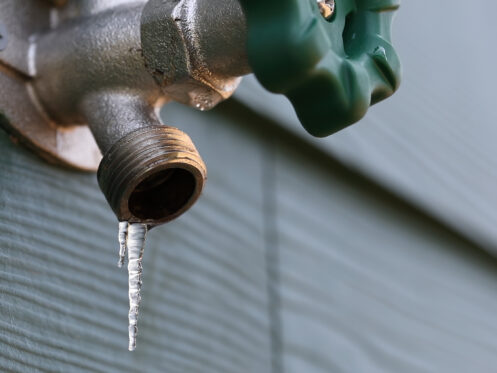As winter settles in, your plumbing system faces a few extra challenges. Frozen pipes are one of the most common and costly issues during the colder months. When the water within your pipes freezes, it may cause them to fracture or break, resulting in costly repairs and unnecessary water damage. The silver lining? With some preparation and simple maintenance, you can avoid this headache altogether.
1. Let Faucets Drip
It may seem counterintuitive, but allowing your faucets to drip during freezing weather can help prevent pipes from freezing. Water moving through the pipes is much less likely to freeze than when it’s sitting stagnant. Even a tiny drip from a faucet is enough to keep the water flowing and reduce the risk of freezing.
This technique is beneficial in areas of your home that are particularly vulnerable to freezing, such as exterior-facing walls or unheated rooms. If you know that temperatures are going to drop significantly, turn on the faucets in places where pipes are most at risk. Focus on sinks located along exterior walls or in rooms isolated from the rest of the house. You don’t need to leave the faucet on full blast — just a tiny, steady drip will do the trick.
In addition to preventing freezing, dripping faucets can help prevent pressure from building up inside your pipes. When water freezes in a pipe, it creates a blockage, which can cause pressure to build up behind the ice. The pipe could burst because of this pressure. Letting the faucet drip helps relieve some pressure, reducing the risk of a pipe bursting.
2. Insulate Your Pipes
One of the most effective ways to prevent your pipes from freezing is to keep them warm. Insulation is your best friend when it comes to protecting your plumbing. Many homeowners overlook this simple step, but adding insulation around your lines can help prevent freezing. When pipes are exposed to cold air, they can freeze quickly, especially in areas of your home that aren’t heated, such as basements, attics, crawl spaces, and garages.
First, focus on the most vulnerable areas — typically the pipes that run along exterior walls or unheated spaces. You can buy foam pipe insulation at most hardware stores, which is easy to wrap around your pipes. If you have exposed pipes in places like the attic or basement, use foam sleeves or insulation tape to insulate them. If your garage is unheated, the pipes along the exterior wall of the garage are especially susceptible to freezing, so make sure they’re properly insulated.
To add an extra layer of safety, think about adding insulation to any areas where pipes are most at risk of freezing, such as under sinks, along exterior walls, or near vents. Insulation keeps the cold air away from the pipes, helping maintain a temperature that prevents freezing.
3. Keep Your Home Warm While Traveling
It’s important to keep your home at a safe temperature so that pipes don’t freeze if you are traveling or will be gone for a long time during the winter. Many people assume that as long as the thermostat is set to a low, energy-saving temperature, everything will be fine, but that’s not always the case. Even during a short absence, temperatures inside your home can dip low enough for pipes to freeze, especially if your home has areas with poor insulation or drafts.
To keep your pipes safe, set your thermostat to at least 55 degrees Fahrenheit when you’re not home. This helps make sure your house stays warm enough to prevent your pipes from freezing. If you’re worried about energy costs, a programmable thermostat could be a great option. It lets you keep a consistent temperature without constantly adjusting the heat, saving you some time and stress. If you’re away for several days, a smart thermostat can even alert you if the temperature in your home drops too low, giving you time to take action before pipes freeze.
If you can’t keep the temperature up in your home for any reason, consider opening cabinet doors under sinks where pipes are located. Allowing warm air from your home to circulate around the plumbing can help prevent freezing, especially in colder rooms or spaces. It’s a simple and effective way to keep your pipes safe during the winter.
4. Maintain Your System
Whether you have a furnace, boiler, or heat pump, it’s important to ensure your heating system runs smoothly and efficiently all winter. Start by having your heating system inspected before the cold weather arrives. A professional inspection can spot small issues before they become bigger problems, such as clogged air filters, worn-out belts, or dirty burners. Regular maintenance ensures your heating system runs smoothly, helping it perform better and reducing the chances of a breakdown when you need it most during the winter.
If you’re using space heaters to warm certain areas of your home, follow all the safety guidelines to prevent fire hazards. Keep flammable materials away from heaters, and always turn them off when you leave the room. It’s also a good idea to monitor the temperature of the areas where pipes are located to ensure that the heat is sufficient to prevent freezing.
5. Seal Any Cracks or Gaps
Another often overlooked but essential step in preventing frozen pipes is sealing any cracks or gaps around your pipes. Cold air can slip in through the tiniest gaps, and if those gaps are near your pipes, they can freeze. Sealing these holes is easy, and it can make a big difference in keeping your home warm and your pipes safe.
Start by inspecting your home for any cracks or gaps near areas where pipes are located, such as around windows, doors, or exterior walls. Pay attention to areas where plumbing enters your home, such as around water supply lines and vents. Apply caulk or weatherstripping to any cracks or holes in the wall to keep cold air from getting to your pipes. You can also add insulation to areas that are particularly exposed, like the rim joist in basements or crawl spaces, to help keep things warmer.
If you have gaps where pipes are located — such as around electrical outlets, light switches, or vents — consider adding insulation to help maintain a steady temperature.
Protect Your Pipes Today
By taking a few simple precautions, like keeping your home warm and covering areas that could freeze, you can protect your pipes from freezing and avoid the expensive repairs that come with burst pipes. At Level 9 Heating, Cooling, and Plumbing in Washington, MO, we help you keep your home safe from frozen pipes and ensure your plumbing remains reliable during the colder months. We also offer smart AC, indoor air quality, heating maintenance, HVAC repair, HVAC installation, HVAC maintenance, humidifier, and dehumidifier services. If you need help winterizing your plumbing, call us at Level 9 Heating, Cooling, and Plumbing today.



